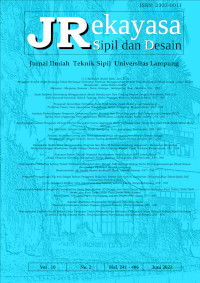Pemanfaatan Limbah Plastik Bekas Gelas Kemasan Untuk Meningkatkan Kekuatan Campuran Beton Sebagai Bahan Rigid Pavement
DOI:
https://doi.org/10.23960/jrsdd.v10i2.2636Abstract Views: 226 File Views: 115 File Views: 0
Abstract
Concrete is the main material of rigid pavement that can withstand compressive strength and weak to tensile strength. Flexural tensile strength on rigid pavement itself is a benchmark in concrete pavement. To increase the value of the flexural tensile strength can be done by adding fiber to the concrete mixture. The purpose of this study was to determine the effect of the addition of plastic waste from plastic packaging made of polypropylene on the compressive strength and flexural tensile strength of concrete.In this study, the addition of used plastic waste pieces from packaged glass used fractional volumes of 0%, 0.1%, 0.3%, 0.5%, and 0.7% of the volume of concrete mixture. The samples for this study were a cylinder with a diameter of 15 cm and a height of 30 cm for the compressive strength test and a beam measuring 15 x 15 x 60 cm for the flexural tensile strength test. The test was carried out after the concrete had been 28 days old. The result of this research is the compressive strength decreased along with the amount escalation of the fiber to the concrete mixture. The flexural tensile strength maximum occur of the addition of plastic fibers at 2% volume fraction increased by 23,75% compared to flexural tensile strength of normal concrete. As a result of adding plastic fibers to the concrete mixture, it also decreased the workability of the concrete mixture
Downloads
References
Abu Abdo, A.M. and Jung, S.J., 2019. Evaluation of enforcing rigid pavements with plastic waste fibers. ARPN Journal of Engineering and Applied Sciences, 14 (13), 2348–2355.
ACI 318-19, 2019. Building Code (ACI 318-19) and Commentary on Building Code Requirements for Structural Concrete (ACI 318R-19). American Concrete Institute. Farmington Hills.
ASTM, C., 2002. Astm C78/C78M -18: Standard Test Method for Flexural Strength of Concrete (Using Simple Beam with Third-Point Loading)ASTM International. USA.
ASTM C39/C39M, 2003. Standard Test Method for Compressive Strength of Cylindrical Concrete Specimens 1. ASTM Standard Book.
Kementerian PUPR, 2017. Konsep Dasar dan Konstruksi Perkerasan Kaku. Modul 1 Konsep Dasar Konstruksi Perkerasan Kaku. Bandung.
Rahmawati, A., 2017. Comparison Of Utilization Polypropilene (PP) And High Density Polyethylene (HDPE) On Laston_WC Mixture. Media Teknik Sipil, 15, 11–19.
SNI 1974, 2011a. SNI 1974-2011 Cara Uji Kuat Tekan Beton dengan Benda Uji Silinder. Badan Standardisasi Nasional Indonesia. Jakarta.
SNI 2847, 2019. Persyaratan Beton Struktural untuk Bangunan Gedung dan Penjelasan (SNI 2847:2019). Standar Nasional Indonesia (SNI). Jakarta.
SNI 4431, 2011b. SNI 4431-2011 Cara uji kuat lentur beton normal dengan dua titik pembebanan. Badan Standar Nasional Indonesia. Jakarta.
Suhardiman, M., 2011. Kajian Pengaruh Penambahan Serat Bambu Ori. Jurnal Teknik, 1 (2), 8.
Vavidel, T.S. and Doddurani, M., 2013. An Experimental Study on Mechanical Properties of Waste Plastic Fiber Reinforced Concrete, 2 , March (3), 7.
Vilanova, A., Fernandez-Gomez, J., and Landsberger, G.A., 2011. Evaluation of the mechanical properties of self compacting concrete using current estimating models: Estimating the modulus of elasticity, tensile strength, and modulus of rupture of self compacting concrete. Construction and Building Materials, 25 (8), 3417–3426.
Downloads
Additional Files
Published
How to Cite
Issue
Section
License

JRSDD is licensed under a Creative Commons Attribution-NonCommercial 4.0 International License.

